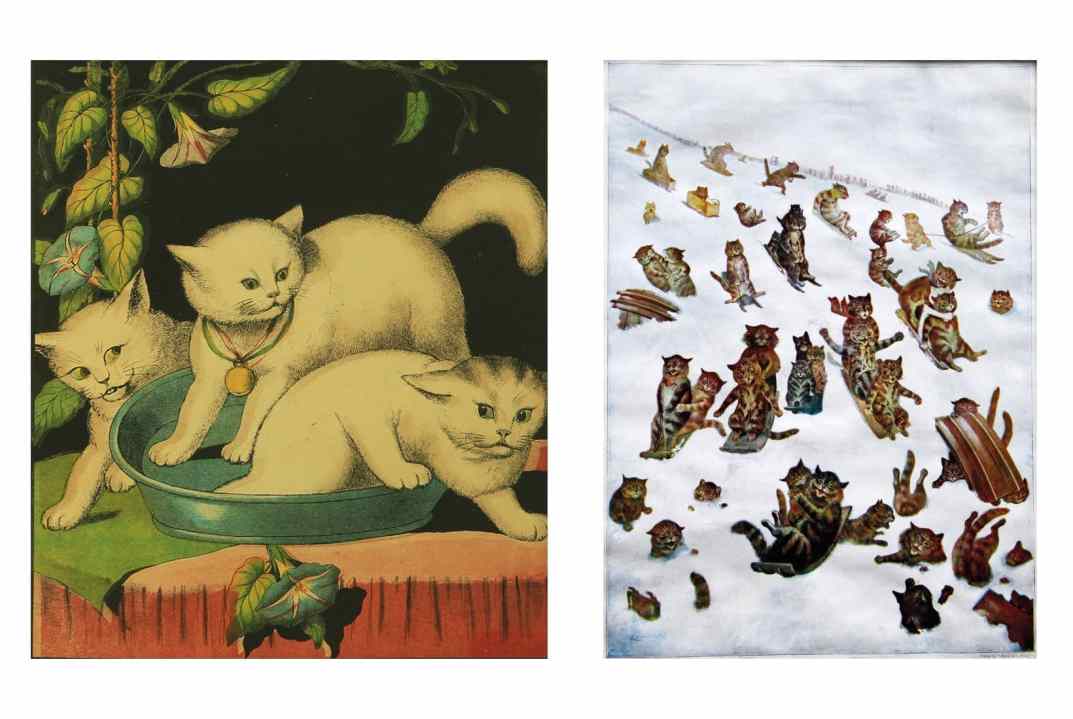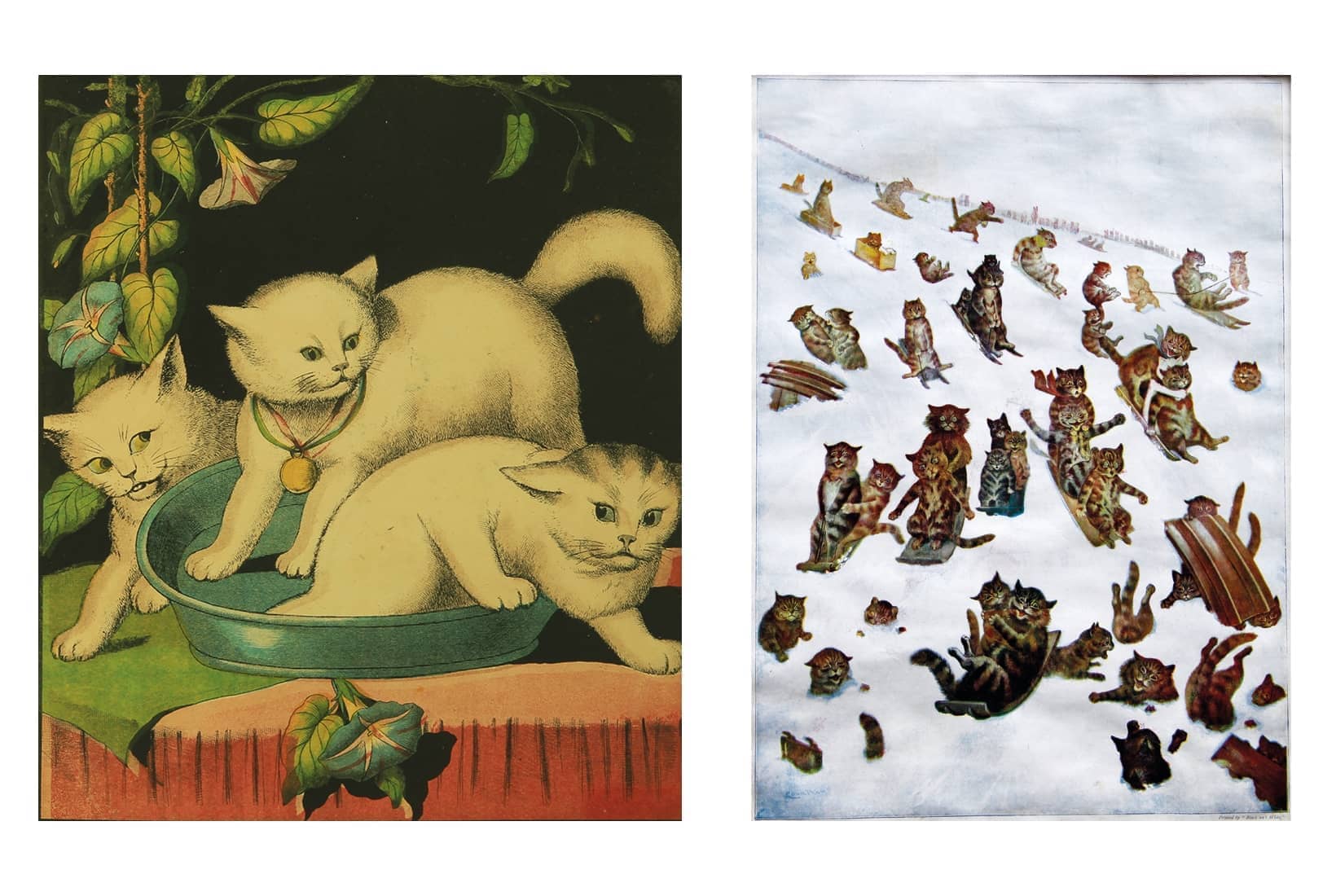Before Tom Kitten, before Felix the Cat, before Thomas ‘Tom’ Cat, Sylvester James Pussycat Sr, Top Cat and Fat Freddy’s Cat, there were the cats of Louis Wain.
The Wain cat came in a variety of breeds and colours: black and white, tabby, marmalade, white and blue (sky blue rather than Persian). But it always had the same disconcerting look in its wide, glassy eyes with the dilated pupils. It looked bombed out of its tiny mind.
The original Wain cat was a black-and-white kitten called Peter belonging to a young late-Victorian magazine illustrator and his sick wife. In 1884 the 24-year-old Louis Wain had married his sisters’ governess, Emily Richardson, only for his new wife to fall ill with breast cancer. To amuse the invalid her loving husband took to drawing sketches of Peter in comical poses, which she encouraged him to show to his editors. In December 1886 a commission duly came from Sir William Ingram, owner of the Illustrated London News, for a double-page drawing of ‘A Kittens’ Christmas Party’. Wain went to town, spending 11 days on a tour de force featuring 150 kittens with different expressions. The Wain cat was launched. Within days of publication its creator had lost his wife but was on his way to fame, though never fortune.
The Wain cat always had the same disconcerting look in its wide, glassy eyes: bombed out of its tiny mind
With his transformation of the humble mouser into a feline version of the Edwardian at play, Wain had hit on a winning formula. He created a sort of Bertie Wooster world with whiskers in which cats played a range of sports, enjoyed cultural activities — from lectures to ‘mewsical’ evenings — and followed fashionable fads from hydrotherapy to phrenology. Inevitably, things went comically wrong; the humour is as basic as the saucy seaside postcard without the smut. Nevertheless Wain prided himself on having, with Peter’s assistance, improved the cat’s social status, helping ‘to wipe out, once and for all, the contempt in which the cat has been held in this country’. H.G. Wells emphatically agreed: ‘English cats that do not look and live like Louis Wain cats are ashamed of themselves,’ he would later declare.
Unfortunately things went wrong for the artist too. Since his father’s death in 1880 when he was just 20, Wain had been the main breadwinner of the family, with five sisters and a mother to support. But despite putting in 14-hour days and pulling all-nighters, he was constitutionally incapable of making money. Naturally shy and retiring, he never tried to copyright his images, reproduced not just in books but on biscuit tins, china and, most prolifically, postcards. Between 1900 and 1940, 1,100 Wain postcards were distributed by 75 publishers, none of whom seems to have paid royalties.
By 1907 he had become the victim of his own success; with the market already flooded with Wain cats, there was little call for more. Sued for debt, he left for America to draw strip cartoons for Hearst Newspapers, but when his financial problems persisted on his return his habitual eccentricity began to veer into paranoia. In 1924 he was certified insane and admitted to the pauper ward of Springfield Hospital in Tooting. He would spend the rest of his life in successive psychiatric hospitals, from Bethlem to Napsbury, where he died aged nearly 80 in 1939. In these 15 years, freed from commercial pressures, he produced his most original work.
It’s a story crying out for a biopic and Benedict Cumberbatch has now obliged by producing The Electrical Life of Louis Wain, a new film with himself in the title role. In anticipation of the film’s release on New Year’s Day, Bethlem Museum of the Mind has opened an exhibition of 50 works spanning the artist’s 60-year career, from a conventional early drawing of a village to the late series of ‘psychedelic’ ‘Kaleidoscope Cats’ — half-cat, half-kaftan — whose rediscovery in a Notting Hill junk shop by the psychiatrist Walter Maclay would lead to Wain’s posthumous acclamation as a proto-freak by the 1960s generation.
Maclay, who with fellow psychiatrist Eric Guttmann conducted experiments with artists on mescaline, believed that art could be an indicator of pathology. Were Wain’s ‘Kaleidoscope Cats’ a testament to the creative power of psychosis? He certainly had some peculiar notions about the feline species, believing at one point that it tended to face north due to ‘the electrical strength of its fur’. But his ‘Kaleidoscope Cats’ are no drug-crazed scribbles; they’re as carefully ordered as paintings by Arcimboldo.
They may in fact have a perfectly sane explanation. Wain’s family were in the textile trade: his father was a travelling textile salesman, his Anglo-French maternal grandmother was a tapestry designer and his mother designed church embroideries and Turkish-style carpets. Colourful ornamental patterning was in his blood. He was also a fluent mirror-writer capable of drawing simultaneously with both hands. His biographer Rodney Dale has ingeniously suggested that in his Rorschach-like kaleidoscopic images he might simply have been amusing himself by exercising that facility. Like any illustrator, Wain drew on a wide range of sources. He believed in ‘entering into the spirit of the age, being sensitive to all its crazes; he even produced a set of porcelain ‘Lucky Futurist Mascots’ inspired by the 1912 Italian Futurist exhibition.
One of Wain’s less batty beliefs was that keeping cats was good for their owner’s health. In the spirit of our own age, with its lockdown-fuelled faith in the therapeutic benefits of furry friends, the Wain cat seems set for another revival — this time wearing an animal therapy hat.
The Electrical Life of Louis Wain is in cinemas from 1 January. Animal Therapy: The Cats of Louis Wain is at Bethlem Museum of the Mind until 14 April.







Comments